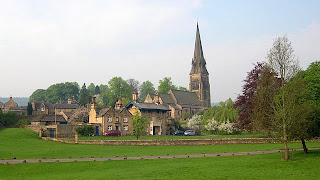 The small estate village of Edensor, pronounced ‘Ensor’, is set in one of the most beautiful locations in the country in parkland owned by the Devonshire family, whose stately home at Chatsworth House is only five minutes walk away. Mentioned in the Domesday Book, the village has been re-sited since then. Originally it lay between the river and the road through the Park, when the houses were set out in a straggling line down to the Derwent.
The small estate village of Edensor, pronounced ‘Ensor’, is set in one of the most beautiful locations in the country in parkland owned by the Devonshire family, whose stately home at Chatsworth House is only five minutes walk away. Mentioned in the Domesday Book, the village has been re-sited since then. Originally it lay between the river and the road through the Park, when the houses were set out in a straggling line down to the Derwent.This did not appeal to the fourth Duke of Devonshire who having spent considerable money and effort improving the House, redesigning the gardens and building a grand new bridge over the river, decided to take down those houses visible from the House. The tenants were re-housed in the nearby estate villages of Pilsley and Beeley. The sixth Duke completed the dismantling of the old village and built the present one.
One house and garden on the riverside of the road, surrounded by a stone wall, still remains. Spared it is believed, because the tenant, an elderly man, did not want to move and the duke in an act of kindness allowed him to stay. Under the brow of the hill it was not visible from the House.
Joseph Paxton, who remodelled and landscaped the gardens at Chatsworth, chose the site for the new village, but it was John Robertson a relatively unknown architect from Derby who provided the designs. At that time aspiring young architects such as Robertson would prepare a book of house plans as part of their training.
It is thought that Robertson approached the Duke to show him the plans when he was busy with other matters and that after quickly looking through them he could not make up his mind and chose all the different styles in the book. The designs ranging from Norman to Jacobean, Swiss-style to Italian villas are all here at Edensor. A few of the old houses remained virtually untouched including parts of the old vicarage, two cottages overlooking the green and the old farmhouse which now houses the post office, shop and tea rooms.
 Robertson retained the 14th century church, but only about 30 years after the completion of the model village it was replaced by a much larger one built by George Gilbert Scott. The new church with its graceful spire and spacious layout added to the status and importance of the village. A more recent addition that helps make the village more complete is the green, added in 1948 after the demolition of the school.
Robertson retained the 14th century church, but only about 30 years after the completion of the model village it was replaced by a much larger one built by George Gilbert Scott. The new church with its graceful spire and spacious layout added to the status and importance of the village. A more recent addition that helps make the village more complete is the green, added in 1948 after the demolition of the school.St Peter’s Church contains one of the finest monuments in the county. This commemorates Henry and William Cavendish, the sons of Bess of Hardwick, the latter son being the First Earl. In the chancel is a brass plaque which records the death of John Beaton, the loyal servant of Mary, Queen of Scots who was imprisoned at Chatsworth House during part of her period in captivity. Also in the church, in a glass case is a wreath of everlasting flowers sent by Queen Victoria to the funeral of Lord Frederick Cavendish, tragically killed in Ireland while on a peace mission. Joseph Paxton is buried in the churchyard in a grave of much grander scale than that of his master, the sixth Duke.
At the top of the churchyard is the grave of Kathleen Kennedy, the sister of the late President of the USA. She was the wife of the present Duke’s elder brother and heir to the Dukedom who was tragically killed in Belgium during the last war. Only four years later his wife was killed in an air crash.
In June, 1963, John F Kennedy, the President of the United States visited the grave -- five months before being assassinated – on the way by helicopter to a meeting with the Prime Minister. This event is recalled by the Duchess of Devonshire in her book, ‘The House: a Portrait of Chatsworth’, when she describes the reaction of one resident of the village, ‘The wind from that machine blew my chickens away, and I haven’t seen them since’.

The architect, Sir Jeffery Wyatville was employed in designing the two gate lodges; one an Italianate villa, the other in complete contrast an English Lodge to mark the entrance to the park. Through the park gates on the right the lane in the village forks; Edensor Lane bearing right and Japp lane to the left. The old coach house and stables have been converted into comfortable flats for retired employees.
Edensor House, occupied for a time by the present Duke and Duchess, has been used to entertain royalty. Outside the park gates the handsome brick building was formerly an inn to serve travellers; villagers had to be content with a makeshift alehouse in one of the cottages. This inn later became Chatsworth Institute and is now occupied by Chatsworth Estate Offices in front is a bowling green and to the side a golf course. The old alehouse cottage still exists, as do the iron staples from where the inn sign hung.
*Repost: www.derbyshire-peakdistrict.co.uk









0 komentar:
Posting Komentar